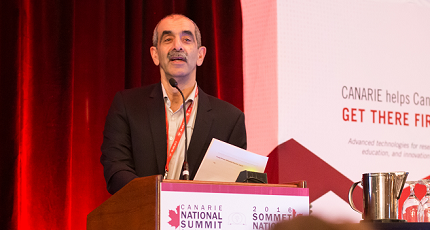On our way to TICAL2019 and the 3rd Latin American e-Science Meeting, that will be held together between September 2-4, in Cancún, it’s time to know better the international speakers who will share their experiences with the region’s ICT and research communities. In our first interview we meet the President and CEO of the Canadian academic network CANARIE, Jim Ghadbane. Experienced leader in the ICT industry, as leader of CANARIE, Ghadbane is responsible for achieving the institution’s objectives, as indicated by the network agreement with the Government of Canada. In this conversation, he shares some of his views on how NRENs can be relevant nowadays and gives us glimpses of his talk in TICAL.
Mexico is not that far from Canada, but for many years the relations between RedCLARA and Canarie were not so close. How do you see this approach - especially after the Summit of the Americas - and what lessons can we learn together?
If the question is about why the CANARIE / RedCLARA were not very close in the past, I would say the simple answer is the focus of the presidents of the two organizations. It’s very simple for the focus of an NREN president to be within their area of influence, and miss the need that international relations are critical to success of the entire system.
Among your activities as President and CEO of Canarie you have to help Canadian Higher Education Institutions, and companies to advance in innovation and commercialization efforts. How is this process being developed and how can the Latin American NRENs serve as a tool for social and economic development in the region?
As CANARIE is funded by the government of Canada (GC) and not directly by member institutions, we also provide services outside of higher education that support GC policies and priorities in a manner that multi-purposes the GC investment in CANARIE. As an example, CANARIE offers cloud compute and storage services to support R&D in small businesses within Canada, these services are able to leverage the CANARIE network.
You have large experience in the "industrial" world. How can NRENs be more competitive in its offer of products and services at a time when there are so many options?
NRENs should not see themselves as competing with the private sector, or anyone else. The most successful model I’ve observed is when the NREN or the regional network is seen as an operating arm of the higher education community it serves. Examples include: supporting higher education with bulk purchasing to lower the price of services, being the eduroam operator to meet the needs of all of higher education, managing connectivity within the jurisdiction of the NREN but also international connectivity. Success of an NREN can be measured by whether the community asks its NREN first to see if it can solve a common problem it has, or whether the NREN is expected to respond to needs through a competitive procurement process. As an example, CANARIE was the first organization to ask to consider operating a security operations center for higher education, the CIOs were not interested in seeing what was available in the market place and asking CANARIE to compete if we wanted the ‘business’.
What will be the main topics of your presentation in TICAL2019?
At this point, I intend to discuss what I’ve learned about what it takes to succeed as a federation operator, much like the role that RedCLARA has within its jurisdiction.





